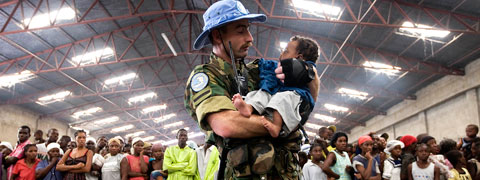Protection of civilians
Civilians have increasingly become the victims of armed conflict. In response, the Security Council has mandated a number of peacekeeping operations with the protection of civilians (POC) from physical violence.

UN Photo/Marco Dormino
A member of the Argentinean battalion of MINUSTAH holds a young Haitian child.
This challenging mandate is often the yardstick by which the international community, and those whom we endeavour to protect, judge our worth as peacekeepers. The first peacekeeping operation to have received this mandate was UNAMSIL - UN Assistance Mission in Sierra Leone - in 1999.
The Department of Peacekeeping Operations (DPKO) and the Department of Field Support (DFS) have devoted significant attention to improving our performance in this area:
- We have worked with our peacekeeping operations to develop a conceptual framework for POC;
- We have supported our operations to develop comprehensive POC strategies, which assists them in harnessing all available resources for the task;
- We are developing protection of civilians training courses targeted at personnel about to deploy, as well as those already working in peacekeeping operations. These courses are aimed at military, police and civilian personnel.
Challenging mandate
Peacekeeping operations have faced innumerable challenges in implementing this extremely complex, but critically important mandate:
- We often protect civilians in harsh conditions, with limited or insufficient resources, and with partners who sometimes lack the will or capacity to do their part.
- Peacekeeping operations often deploy amidst the unrealistic expectation that they will be able to protect all civilians at all times.
- The dynamic nature of the places in which we operate means the security situation can change very quickly.
Failures to protect civilians rightfully receive widespread publicity. However, it is important to recognize the tens of thousands of UN peacekeepers who put themselves in harm’s way every day in order to protect civilians from the effects of physical violence.
Moving forward
It is important to understand that the protection of civilians is not solely the responsibility of UN Peacekeeping operations. It is a systemic effort that includes:
- the Security Council which provides protection of civilians mandates;
- DPKO and DFS who plan, deploy and manage peacekeeping operations;
- The troop and police contributing countries that provide the personnel for our operations;
- The peacekeepers on the ground who implement the mandate provided to them;
- Most importantly, the host government has the primary responsibility for protecting its citizens;
Improving protection of civilians in the context of UN Peacekeeping operations must be addressed holistically, with a view to improving the performance of all actors who share a stake in protecting innocent civilians from physical violence.
Security Council meetings on Protection of Civilians
Since 1999, the Security Council has met regularly on the issue of Protection of Civilians. Download a full list of these meetings ![]() , including associated resolutions, Presidential Statements, Secretary-General’s Reports, and press releases.
, including associated resolutions, Presidential Statements, Secretary-General’s Reports, and press releases.
Related document
- Protecting Civilians in the Context of UN Peacekeeping Operations: Successes, Setbacks and Remaining Challenges (Independent study commissioned by DPKO and OCHA)